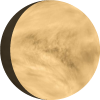Venus Observation Details

Venus Daily Motion
Venus will become visible in February, 25. After being too close to the Sun to observe, it will reappear in the night sky. Starting from February, 25, Venus can be seen again, providing a good opportunity for observation.
Venus Visibility Timetable on January 08
Venus Rise and Set Timetable
| Time | Elevation | |
| Venus transit | 10:15 | 30° |
| Venus set | 15:00 | |
| Astrosession begin | 16:39 | -18° |
| Moon Rise, 73.2% illuminated | 20:11 | -60° |
| Astrosession end | 03:49 | -19° |
| Venus rise | 05:32 | |
| Moon Set | 08:42 | 26° |
Track Venus Position Throughout the Night
← Thu, 8 January 2026 →
| Time | |
| Altitude | |
| Azimuth |
Shift the map to change the time and observe Venus changing position in the night sky.
Where is Venus right now?
Venus is located in the constellation Sagittarius, at right ascension 19h 20m 35s" and declination -22° 55' 21s, approximately 1.71 AU (255,812,359 km) from Earth. At the current time, it is below the horizon and not visible from your location.Upcoming Events
| Time | Description | Constellation |
|---|---|---|
| Sat, 15 August 2026 | Greatest Elongation of Venus | Virgo |
| Fri, 2 October 2026 | Retrograde motion of Venus begins | Virgo |
| Sun, 25 October 2026, 14:00 | Virgo | |
| Wed, 11 November 2026 | Retrograde motion of Venus ends | Virgo |
| Mon, 4 January 2027 | Greatest Elongation of Venus | Libra |
Current position of Venus in Solar System
| Date | Thu, 8 January 2026 |
| Distance from Earth to Venus | 1.711 AU (255,961,957km) |
| Elongation | 1° |
| Angular diameter | 9.8" |
| Magnitude | -3.9 |
Finder Chart for Venus
Double-click to unlock the map.
| Object name | Venus |
| Field of view | |
| Limiting magnitude | |
| Venus coordinates | 19.3432, -22.9225 |
| Center coordinates | 19.3432, -22.9225 |
Venus Passage Through Night
Double-click to unlock the map.
Current position of Venus
| Time | 23:15 |
| Latitude | 37.3541 |
| Longitude | -121.955 |
| Venus elevation | -71° |
| Venus Azimuth | -45° |
Here you can see the current position of the Venus on the map, as well as its positions for rise and set. This tool allows you to track the Venus's movement throughout the night, providing you with accurate and up-to-date information.
Annual motion of Venus
| Date | Fri, 9 January 2026 |
| Twighlight start | 16:35 |
| Twighlight end | 03:43 |
| Twighlight duration | 11h 8m |
| Rise | 05:30 |
| Set | 14:58 |
| Elevation at transit | 30° |
| Transit time | 10:14 |
| Equatorial coordinates | RA: 19h 23m 55s", Dec: -22° 50' 05s |
| Magnitude | -4 |
| Constellation | Sagittarius |
The graph illustrates the annual visibility pattern of a Venus, providing a comprehensive overview of its daily appearances and transit times throughout the year.
The graph is structured with the vertical axis showing the hours of the day, ranging from 12 AM to 12 AM the next day, while the horizontal axis spans each day of the year.
The reddish shaded area indicates the periods when the Venus is above the horizon, visible to observers. The white line marks the times when the celestial object reaches its highest point in the sky each day, known as the transit.
The graph is structured with the vertical axis showing the hours of the day, ranging from 12 AM to 12 AM the next day, while the horizontal axis spans each day of the year.
The reddish shaded area indicates the periods when the Venus is above the horizon, visible to observers. The white line marks the times when the celestial object reaches its highest point in the sky each day, known as the transit.
Astrometric & Physical Parameters of Venus
Coordinates & Visibility
| Right Ascension | 19.3432° |
| Declination | -22.9225° |
| Magnitude | -3.9 |
| Constellation | Sagittarius |
| Elevation | -70.9° |
| Azimuth | -45.1° |
Basic Properties
| Mass, kg | 4.8685E+24 |
| Mean density, g/cm³ | 5.204 |
Rotation
| Sidereal rotation period, days | 243.018484 d |
| Mean solar day, hours | 116.7490 d |
Surface & Atmosphere
| Surface gravity, m/s² | 8.870 |
| Escape velocity, km/s | 10.361 |
| Surface pressure, bar | 90 |
| Mean temperature, K | 735 |
Brightness
| Visual magnitude V(1,0) | -4.40 |
Data Acknowledgment
Our solar system data—including planetary physical and orbital parameters—comes from the Solar System OpenData API , maintained by Le Système Solaire. We thank Christophe and the contributors for making this open data available.
